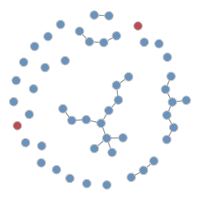28 Introduction
In this module we will cover two topics: how to model heterogeneity associated with nodal attributes in networks, and how to use data collected using network study designs as inputs to EpiModel.
Core EpiModel is set up to automatically handle three possible types of network data inputs:
Hand calculated target statistics – These are the sufficient statistics for the terms in the model. They can be constructed by the user from empirical data, or as simulation experiments (as we did in Basic Epidemics Module).
Network census data – Empirical data collected from every node and link in the network of interest. This type of data is handled by the
ergmpackage directly, and allows for some types of missing network data (links and nodal attributes) but not others (missing nodes).Egocentrically sampled network data – Empirical data collected from a probabilistic sample of nodes (“egos”) who are asked to report some information on their partners (“alters”). This type of data is handled by the
ergm-egopackage.
Here we will work with data from the latter two network study designs, recall that they were discussed in Network Practice Module. The netest function in EpiModel is set up to take either one as an input.
The tutorial will demonstrate the elements of a full EpiModel workflow, from reading in the network data and exploring it to simulating an epidemic over the dynamic network and analyzing the outputs.
